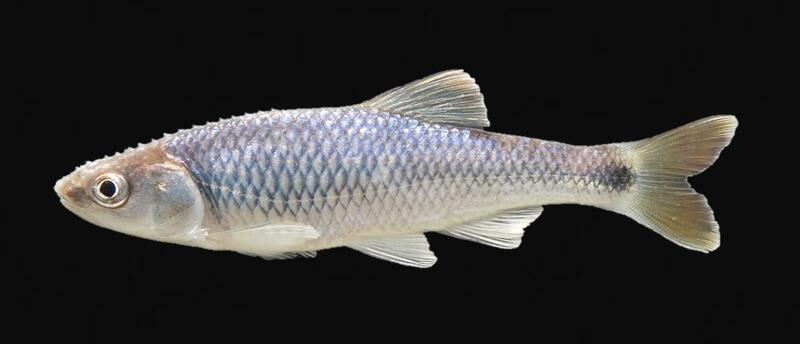







Loading profile. Please wait . . .
Cyprinella xaenura (Jordan, 1877)
Altamaha Shiner





Federal Protection: No US federal protection
State Protection: Threatened
Global Rank: G3
State Rank: S3
Element Locations Tracked in Biotics: Yes
SWAP 2015 Species of Greatest Conservation Need (SGCN): Yes
SWAP 2025 Species of Greatest Conservation Need (SGCN): Yes
2025 SGCN Priority Tier: Moderate Conservation Concern
Element Occurrences (EOs) in Georgia: 76
Habitat Summary for element in Georgia: Medium-sized to large streams in runs or pools over sand to gravel substrate
A robust minnow, the Altamaha shiner can reach a maximum total length of 11 cm (4.3 in). This fish has a pointed snout and a terminal mouth. Coloration characteristics include dusky olive coloration dorsally, a dark dorsal stripe, and a lateral black stripe on the posterior half of the body that can expand to form a spot at the base of the caudal fin. Breeding males are recognizable by a blue coloration on the sides and yellow to orange dorsal, caudal, and anal fins.
The Ocmulgee shiner (Cyprinella callisema) is a sympatric congener that often co-occurs with the Altamaha shiner. The Altamaha shiner differs from this species in having a pointed snout (vs. blunt), a terminal mouth (vs. subterminal), 10-11 anal fin rays (vs. 8), a pharyngeal tooth count formula of 1-4-4-1 (vs. 0-4-4-0), and a caudal spot. The blacktail shiner (Cyprinella venusta) has been recorded from the upper Ocmulgee system. This species is similar to the Altamaha shiner in having a terminal mouth, a 1-4-4-1 pharyngeal tooth count formula and a caudal spot, but differs in having fewer anal fin rays (8-9).
Altamaha shiners inhabit small tributaries and rivers. They are most often found in small pools with rocky to sandy substrates.
Probably aquatic insects or terrestrial insects captured from stream drift.
Little is known concerning the life history of the Altamaha shiner, but based on the similarities between most members of the genus Cyprinella, spawning probably occurs over crevices in rocks or submerged logs where eggs are attached and then fertilized. Breeding males will develop prominent tubercles or bumps on the head and scales. Spawning probably occurs from mid-spring through mid-summer.
Seining is a good method for collecting minnows. Because minnows are often mis-identified, voucher specimens should be kept to document new stream occurrences of the Altamaha shiner.
Altamaha shiners are endemic to the Piedmont portion of the upper Altamaha River drainage of north central Georgia, from both the Ocmulgee and Oconee River systems. See the [Fishes of Georgia Webpage](http://fishesofgeorgia.uga.edu/index.php?page=speciespages/species_page&key=cyprxaen) for a watershed-level distribution map.
Threats to the Altamaha shiner are principally degradation and impoundment of tributary streams in the upper Altamaha drainage. Stream degradation results from failure to employ Best Management Practices (BMPs) for forestry and agriculture, failure to control soil erosion from construction sites and bridge crossings, and increased stormwater runoff from developing urban and industrial areas. Fishes that depend upon small crevices to lay their eggs in are especially vulnerable to impacts of excessive sedimentation. The range of the Altamaha shiner includes the rapidly developing Piedmont physiographic province where many streams have become damaged by urban development to the point that they support only a very few hardy, tolerant fishes. The invasive red shiner, if it spreads throughout the Altamaha system, could be a very significant threat to the Altamaha shiner through hybridization and competitive displacement effects.
| Threat 1 | Threat 2 | Threat 3 | |
|---|---|---|---|
| General Threat | Pollution | Natural system modifications | Pollution |
| Specific Threat | Domestic & urban waste water | Dams & water management/use | Agricultural & forestry effluents |
Historically, this species has been recorded from 25 different HUC 10 watersheds within its range. Between 1998 and 2009, this species has been documented within 18 of these watersheds. Based on the relatively large number of currently occupied watersheds, the state protected status of this species was changed from Endangered to Threatened in 2006.
Conserving populations of the Altamaha shiner depends on maintaining and restoring habitat and water quality in tributaries of the upper Altamaha River drainage. It is essential to eliminate sediment runoff from land-disturbing activities (such as roadway and housing construction), maintain forested buffers along stream banks, eliminate inputs of contaminants (such as fertilizers and pesticides), and maintain natural patterns of stream flow. Watershed clearing and urban development can lead to unnaturally flashy stormwater runoff, which scours stream channels and results in lower baseflows. For these reasons, containing and slowly releasing stormwater runoff from developed areas is an important element in protecting stream habitats for fishes and other aquatic organisms. Impounding streams should be a last resort for developing water supplies.
Dahlberg, M. D., and D. C. Scott. 1971. The freshwater fishes of Georgia. Bull. Georgia Acad. Sci. 29:1-64.
Gibbs, R. H., Jr. 1957. Cyprinid fishes of the subgenus Cyprinella of Notropis. Vol. I. Systematic status of the subgenus Cyprinella, with a key to the species exclusive of the lutrensis ornatus complex. Copeia 1957: 185-195.
Lee, S. L., C. R. Gilbert, C. H. Hocutt, R. E. Jenkins, D. E. McAllister, and J. R.Stauffer. 1980. Atlas of North American fishes. North Carolina State Mus. Nat. Hist. 867pp.
Page, L. M., and B. M. Burr. 1991. A field guide to freshwater fishes of North America north of Mexico. Houghton Mifflin, Boston. 432pp.
Byron J. Freeman
B. Freeman-Original Account: 1999
K. Owers-Updates: January 27^th^, 2009 Added picture, updated status and ranks, added fish atlas link, converted to new format, minor edits to text
B. Albanese-Updates: Feb 11, 2008 Added similar species, conservation status, etc.
Z. Abouhamdan, April 5, 2016: updated link